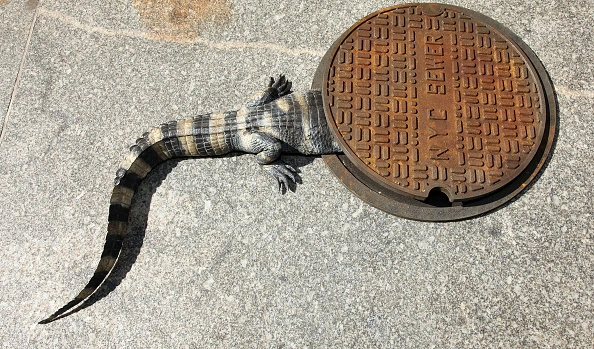
News broke recently of an alligator having to be wrangled in New York’s Prospect Park in the borough of Brooklyn. The authorities are unsure as to how the 4ft reptile came to be in the park’s lake, but they nonetheless issued a reminder not to release unwanted pets into urban areas. Overground or underground.
The story has reignited the conversation as to whether or not alligators have made a home in the Big Apple before. Although native to much warmer climates in the US south-east, many still believe in the tales of the infamous New York sewer alligators. But has there ever been any truth to these?

The history of alligators in the sewer
These beasts, so the stories go, were brought back to the city by rich New York families who’d made some poor buying decisions while on vacation in Florida. Once they tired of their new pets – or at least, realised quite how big and hungry they were going to get – the owners would flush them down the toilet. This, at least, is the main explanation given for how so many people claim to have spotted the reptiles in New York, a city for which the climate is far too cold for them.
As with many urban legends, the story persists because it actually seems to have a grain of truth to it. We can’t verify the tales of posh children flushing baby gators down toilets – but sightings, some verified, some probably made up, have been a feature of the city’s newspapers since the 1930s.
According to the New York Times’ archives, the first sighting of a suspected sewer alligator was in 1932, when one was found lounging on the banks of the Bronx River. The next, and most famous, came three years later when two teenagers shovelling snow in East Harlem came across one nosing its way out of a manhole. The Times ran a penny dreadful-esque headline the next day:
“ALLIGATOR FOUND IN UPTOWN SEWER: Youths Shovelling Snow into Manhole See the Animal Churning in Icy Water. SNARE IT AND DRAG IT OUT: Reptile Slain by Rescuers When It Gets Vicious – Whence It Came Is Mystery.”
(Yes, that is just the headline.)
Since then, there have been regular stories (how reliable is not entirely clear) of alligators spotted in lakes, reservoirs and rivers near the city. None of them, alas, have matched the high drama of the manhole alligator of 1935.
A bit of clarity
While alligators have often been found in and around New York, it seems unlikely that they lived in the sewers – or at least, not for long, since they’d probably die of cold and disease down there. So, to be clear, when we say a grain of truth, we mean just that. There are no thriving colonies of gators down there.
Rather than fearing them, New Yorkers seem to view the city’s phantom alligators as a source of pride.
“The concept of alligators in city sewers is a great myth, and, having done a little research on it, I found that it has a strong basis in reality. I felt people should know that,” said Manhattan Borough historian Michael Miscione.
The New York obsession with alligators seems all the stranger when you consider the fact that smaller reptiles very definitely are swimming around beneath the city’s streets, and no one seems very concerned about them. Snapping turtles are regularly spotted in sewage treatment systems but, for Miscione, they simply don’t have the same appeal.
“They’re not nearly as exotic or dangerous as alligators, and they’re native to this area, so what’s the big deal?” he asked. “No one cares about snapping turtles.” The state’s lawmakers don’t agree: they designated the snapping turtle the official state animal.
Alligators in Paris and London?
The alligator story has also imprinted itself, albeit less deeply, on Paris. In 1984, sewer workers under the Pont Neuf Bridge found a Nile alligator, which had supposedly been eating rubbish and rats to survive. It was christened Eleanore.
In London, there are no alligators that we know of, and fears instead tend to focus on giant rats – perhaps not surprisingly, since they carried the Bubonic Plague that managed to wipe out half the city’s population in the 14th century.
Modern stories about rats, however, have tended to eschew the threat of a new plague, and focus instead on the risk of them growing to giant proportions before emerging from the sewers to wreak havoc.
You’ll be pleased to hear that these reports proved unfounded (so far, at least). But there are reasons to believe that sewer rats are getting bigger, thanks, perhaps unexpectedly, to an increase in recycling. We now rinse packaging out, rather than letting food scraps go to landfill: that gives sewer rats a more plentiful food supply.
As with New York’s alligators, this problem is apparently the fault of a particular class. In Elton’s Ecologists, a history of the now-defunct Oxford Bureau of Animal Population, author Peter Crowcroft blames the apartment-dwelling middle classes for feeding the sewer rats:
“Sewer rats do well in areas which are thickly populated by humans who are neither very rich nor very poor. Such people, especially apartment dwellers, tend to waste food, often flushing it into the drains in useful fragments, instead of converting it into an unavailable sludge with grinding machines installed in sinks.”
So, when the mutant rats really do take over, we’ll know who to blame.
[Read more: Overfishing: Why coastal fishing cities need to act now]






